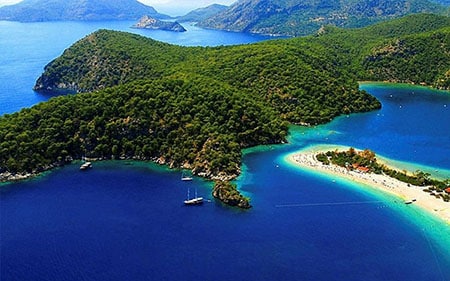Turkey is a transcontinental country, with about 3% of its territory in southeastern Europe (Thrace) and 97% in Asia (Anatolia or Asia Minor). It is surrounded by three major bodies of water: the Aegean Sea to the west, the Mediterranean Sea to the south, and the Black Sea to the north. The Sea of Marmara, along with the Bosporus and Dardanelles straits, connects the Black Sea to the Aegean, marking the boundary between Europe and Asia. Turkey is a transcontinental country, meaning it spans both Europe and Asia:
1. European Turkey:
This part of Turkey is called Thrace (or Trakya in Turkish).
It is located on the eastern edge of Europe, comprising about 3% of Turkey’s land area.
Major cities in this region include Istanbul (partly in Europe and partly in Asia) and Edirne.
The Bosporus Strait separates the European and Asian sides of Istanbul.
2. Asian Turkey:
The larger portion of Turkey, known as Anatolia or Asia Minor, is in Asia.
This region covers about 97% of Turkey’s landmass and includes major cities like Ankara (the capital), Izmir, Antalya, and Cappadocia.
It is bordered by the Aegean Sea to the west, the Mediterranean Sea to the south, and the Black Sea to the north.
Cultural and Geographical Significance:
Istanbul, straddling both Europe and Asia, is one of the few cities in the world located on two continents, symbolizing Turkey’s unique blend of Eastern and Western cultures.
Turkey’s terrain is varied, featuring coastal plains, mountain ranges like the Taurus and Pontic Mountains, and central plateaus. The country also has unique landscapes like Cappadocia and the cotton-like terraces of Pamukkale. Turkey is home to some of the world’s earliest civilizations, including the Hittites, Phrygians, and Lydians. It was also a central region for the Greeks and Romans, with notable ancient cities like Ephesus, Troy, and Pergamon. Istanbul, formerly known as Byzantium and then Constantinople, was the capital of the Byzantine Empire for over a millennium.
From the 14th century to the early 20th century, Turkey was the heart of the Ottoman Empire, one of the most powerful empires in history. The empire’s influence extended across Southeast Europe, Western Asia, and North Africa. The Ottoman Empire dissolved after World War I, and under the leadership of Mustafa Kemal Atatürk, the Republic of Turkey was established in 1923. Atatürk initiated major reforms to modernize and secularize the country.
UNESCO World Heritage Sites
Turkey boasts several UNESCO World Heritage Sites, including:
Göbekli Tepe: One of the oldest known temples in the world.
Cappadocia: Famous for its fairy chimneys and ancient cave dwellings.
Pamukkale-Hierapolis: Known for its stunning travertine terraces.
Mount Nemrut: Notable for its giant statues and ancient tomb-sanctuary.
Ephesus: An ancient Greek city with well-preserved ruins like the Temple of Artemis and the Library of Celsus.
Turkey is a vibrant country where ancient traditions meet modern innovations, offering a diverse experience to both visitors and residents. Its mix of historical depth, cultural richness, and natural beauty makes it a fascinating destination on the global stage. So, Turkey is both in Europe and Asia, making it a unique bridge between the two continents.
